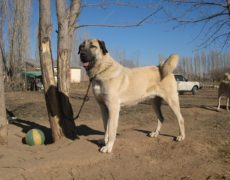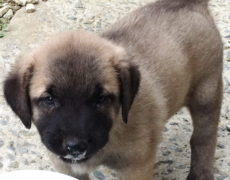Kangal Dog
Kangal dog, a purebred dog with large, powerful body and heavy bones, is typically used as a flock guardian, actively protecting flocks of sheep from predators like bears, jackals, and wolves. Distinguished by moderately large wide heads, drop ears, black masks, black velvety ears, and a curled tail, kangal dogs have slightly longer body than its height with a front leg that measures over one-half of the height.
Kangal Dog Pictures
- Kangal Dog Fight
- Kangal Dog Images
- Kangal Dog Photos
- Kangal Dog Pictures
- Kangal Dog Puppies
- Kangal Dog Puppy Images
- Kangal Dog Puppy Photos
- Kangal Dog Puppy Pictures
- Kangal Dog Puppy
- Kangal Dog
- Kangal Dog Breeders
- Kurdish Kangal Dog
- Turkish Kangal Dog
Quick Information
| Nicknames | Karabash |
| Coat | Moderately short, dense double coat with harsh outer coat and very soft, dense undercoat |
| Color | Solid colors ranging from steel gray, light dun to pale dull gold with white markings on chin, chest, and feet |
| Group of Breed | Flock Guardian |
| Life span | 12-15 years |
| Weight | Male 50-66 kg (110-145 lb); Female 41-59 kg (90-130 lb) |
| Size and Height | Male 29-32 inches (74-81 cm); Female 28-31 inches (71-79 cm) |
| Shedding | Heavy, Seasonal |
| Temperament | Protective, Independent, Sensitive, Self-controlled, Calm, Alert |
| Good with Children | Yes |
| Size of Litter | 5-10 puppies |
| Hypoallergenic | No |
| Barking | Yes when responding to threats |
| Country Originated in | Kangal, Sivas Province, Turkey |
| Competitive Registration | DRA, ACR, NKC, CKC, UKC, APRI, KDCA |
Kangal Dog Video
History and Origin
Kangal dogs are distinct from the basic Anatolian Shepherd Dogs and Akbash. In Turkey, it is believed that it is connected to the early mastiff-types portrayed in Assyrian art. They have been traditionally used by the large chieftains and landholders in Turkey for their outstanding guarding abilities. Introduced in Britain by Charmian Biernoff in 1965, the Kangals gave birth to their first litter in 1967. The Turkish Kangal dog was first imported to USA in 1985 by two Americans Judith and David Nelson, providing the basis for Kangals in the US.
Varieties
- Turkish Kangal Dog
- Kurdish Kangal Dog
Temperament and Intelligence
Being a guardian dog breed, Kangal dogs are defensive of the human family or the domestic animals to which they bond. Despite having a natural aloofness towards strangers, appropriate training makes them sociable. Their alertness urges them respond to dangers with warnings and actions.
Although the dog does not require an extensive caring regimen, inexperienced dog owners would find it difficult to pet them due to their independent intelligence. Being suitable for houses with large yards having good fencing, they do not like inactive apartment life.
Care
Exercise
Kangals working in acreage get enough exercise guarding livestock as also patrolling property. Family dogs require daily jogs, long walks and socialization off-property, without which they become difficult to handle. Take alpha position and act as pack leader while out with your dog.
Grooming
Kangals require little grooming throughout the year. However, their coat requires extra attention and systematic brushing-out every week during the shedding season.
Health Problems
Being a hardy breed, they are not susceptible to major health conditions, except from hip dysplasia, entropion and benign tumors.
Training
Instead of training them harshly, use soft treatments and food rewards, showing true emotions like friendly pats or praises. The puppies should only be patted or fed by his caretaker or owner and but not strangers to prevent them from becoming subservient.
Feeding
The dog kangal should be provided with a low protein dry food. A barley meal produced from boiled or hulled barley is routinely given to these dogs in Turkey.
Differences: Kangal Dog vs. Wolf
| Points of Difference | Kangal Dog | Wolf |
| Common Names | Karabash | Gray wolf, Timber wolf, Western wolf, Red wolf |
| Coat | Moderately short, dense double coat with harsh outer coat and very soft, dense undercoat | Dense, fluffy winter fur; short underfur with coarse guard hairs |
| Color | Solid colors like steel gray, light dun, pale dull gold with white markings on chin, chest, and feet | Predominantly mottled gray; black, brown, red, and pure white are also possible |
| Higher classification | Dog | Canis |
| Height | Male 29-32 inches (74-81 cm); Female 28-31 inches (71-79 cm) | 31.5-33.5 inches (80-85 cm) |
| Weight | Male 50-66 kg (110-145 lb); Female 41-59 kg (90-130 lb) | Male about 50 kg (110 lb); Female about 40 kg (88 lb) |
| Size of Litter | 5-10 puppies | 5-6 puppies |
| Life Expectancy | 12-15 years | 6-8 years on average |
Interesting Facts
- Working kangals usually station themselves on high vantage points to look on to their flock, sometimes digging holes to keep cool on hot days.
- When threatened, they motivate the sheep to assemble around them by giving an alarm call with their erect ears and tail.
- Specialized wolf killers, called kurtcul kangals, fight with wolves if they are not successful in frightening the predators.



















I have a 145 lbs kangal and she is awesome with everything and everyone just over a year old
How is this breed with Poultry. We have goats,horses,1000’s of Pasture poultry.
We have Great Pyrenees at this time. Would they mix in relatively well.
Hi Ron,
The Kangal is a classic livestock guardian and is protective towards the flock by nature. However, the male Kangals do not usually get along well with other males of the same breed. The bottom line is you must familiarize your Kangal with other household pets and the livestock at a young age, preferably during its puppyhood.
i want to buy
a kangal pappy